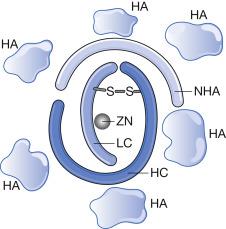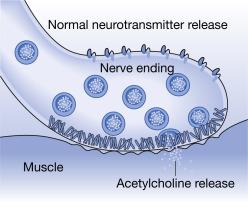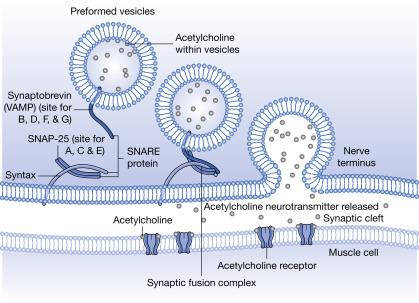Physical Address
304 North Cardinal St.
Dorchester Center, MA 02124
Q60.1 What are the major serotypes of botulinum, and what are the characteristics of botulinum neurotoxin A that make it most suitable for dermatologic use? (Pg. 657)
Q60.2 What is the general mechanism by which botulinum toxin relaxes facial rhytides (wrinkles) and reduces sweating? (Pg. 657)
Q60.3 Specifically, which serotypes of botulinum toxin inhibit SNAP-25 and which serotypes inhibit synaptobrevin (VAMP)? (Pg. 657)
Q60.4 What is the time course and the mechanism by which neuromuscular function recovers following botulinum toxin injection into a muscle? (Pg. 657)
Q60.5 What are reasonably accurate conversion factors for botulinum neurotoxin (BoNT) units with the four main BoNT preparations available to clinicians? (Pgs. 658, 659)
Q60.6 What are the most current ‘nonproprietary’ (generic) names for the four main BoNT preparations available to clinicians? (Pgs. 658, 659)
Q60.7 What are some of the most important patient selection issues and preprocedure discussion points that are essential to successful BoNT injection and patient satisfaction? (Pg. 660)
Q60.8 What are the expected time of onset and duration of action of BoNT injections when used for hyperhidrosis? When is the starch iodine test most optimally used? (Pg. 661)
Q60.9 Will repeated botulinum toxin use result in antibody formation, reduced efficacy, or resistance to the therapeutic benefits? (Pg. 661)
Q60.10 What are some of the adverse effects of botulinum toxin that relate to injection technique? (Pg. 661)
Q60.11 What are the guidelines for safely injecting botulinum toxin in the forehead, glabella, and lateral canthus regions? (Pg. 664x3)
Acetylcholine
Adverse effect/event
Botulinum neurotoxin (previously designated BTX)
Botulinum neurotoxin A
Botulinum neurotoxin B
Calcitonin gene-related peptide
US Food and Drug Administration
Lethal dose to 50% (of mice tested)
Mammalian uncoordinated-18
Neuromuscular junction
Randomized controlled trial
Synaptosomal-associated protein 25
Soluble N -ethylmaleimide-sensitive factor attachment protein receptor
Units
Vesicle-associated membrane protein
History records the life of botulinum neurotoxin (BoNT) from its infamous beginnings as an ancient, deadly poison to its potential as a mysterious biological weapon over 70 years ago. It resurfaced as a benevolent medical curiosity and its use has increased during the last 30 years into the most common cosmetic procedure in the world. It is still a potent neurotoxin, but over the years, clinicians have been able to cautiously harness this power to therapeutic advantage. Remarkable patient satisfaction coupled with a low adverse effect (AE) profile accounts for the explosion in BoNT use. Dermatologists have been at the forefront of recognizing and investigating the BoNT potential and contributing to the ever-expanding list of indications.
Botulism has three forms: food-borne, infantile, and wound-related. Toxicity begins with cranial anticholinergic symptoms (dry mouth, blurred vision, nausea), but can progress to paralysis, cardiorespiratory failure, and death. The German physician Kerner published the first case studies on the illness in the early nineteenth century. Kerner’s brave experiments on himself and laboratory animals provided detailed information on the nature of the neurotoxin’s effects, even allowing him to speculate on its medical applications in controlling sympathetic and neuromuscular hyperactivity. The causative agent was first identified at the end of the nineteenth century by van Ermengem as Bacillus botulinus and later reclassified as Clostridium botulinum . This Gram-positive rod-shaped anaerobic bacterium is spore-forming and can produce a toxin under specific conditions. Toxin production typically occurs in preserved (hence anaerobic) foods, and was first believed to originate from sausage ( botulus is the Latin word for sausage). Van Ermengem noted that the toxin was heat sensitive, but resistant to alcohol and mild acids. He also recorded that different animals were variously susceptible to the toxin. Directed research and development began in the 1920s, and by the mid-1940s, type A toxin was isolated for use by the United States army. BoNT is believed to be the deadliest substance known, with 1 g having the potential to kill 1 million humans. However, early attempts at weaponization were not successful and were largely abandoned.
The medical use of botulinum toxin A (BoNTA) began in the 1950s, but was significantly advanced in the late 1960s when studies by Schantz and Scott showed that extraocular muscles could be weakened by injected BoNTA. The first commercial batch of BoNTA (79–11), known as Oculinum, was prepared in 1979. This initial lot was the source for all BoNTA use in the United States until 1997, and in 1991 the name of this product was changed to Botox (onabotulinumtoxin A, Allergan, USA). The nonproprietary name onabotulinumtoxin A was introduced in 2009 when Dysport (abobotulinumtoxin A, Ipsen, France) was approved by the US Food and Drug Administration (FDA) to reduce the potential for medical errors. Botox was originally approved for the treatment of strabismus, but use for other spasmodic disorders became common, mainly related to extraocular muscles. Subsequently, BoNTA was used for torticollis and other dystonias. In 1987, Canadian ophthalmologist Jean Carruthers shared observations of glabellar rhytid reduction in patients treated for blepharospasm with her husband (and dermatologic surgeon) Alastair Carruthers. The cosmetic potential of BoNTA was tested in many studies by the Carruthers and other medical pioneers, who were among the first to demonstrate efficacy and safety. Since then, an explosion of research has further expanded the use of BoNT in dermatology and beyond.
Q60.1 Clostridium botulinum produces seven known serologically distinct and immunologically independent neurotoxins, serotyped A, B, C, D, E, F, and G. The serotypes have different pharmacological characteristics, but all produce inhibition of acetylcholine (ACH) neurotransmitter release from the neuromuscular junction (NMJ), leading to flaccid muscle paralysis. All BoNT serotypes have a generally conserved small core neurotoxin protein (150 kDa), which is usually noncovalently bound to larger, nontoxic proteins that provide protection against the acidic environment of the gut and the degradative effects of intestinal proteases ( Fig. 60.1 ). During systemic intoxication in botulism, the BoNT complex reaches the bloodstream and the interaction between the hemagglutinin components of the accessory proteins and erythrocytes likely causes the toxic subunit to dissociate from its protein partners and become free to exert its toxic effect. The toxin’s heavy chain (HC) binds to the presynaptic nerve terminal and ultimately allows the light chain to enter the cytosol and cleave proteins required for ACH release. Neurotoxin types C and D have little effect on humans. Serotype A (BoNTA) is the most potent and longest lasting, which is why it was the first commercially available for medical use.

Recent studies using serotype E have yielded interesting results. It appears to have a rapid onset of approximately 24 hours, and a short duration of approximately 30 days. This has advantages for those who want to try neurotoxin but are afraid they may not like it. There may also be a role for serotype E in the reduction of postoperative pain and prevention of postoperative scarring.
In each motor nerve ending there are small intracellular lipid vesicles containing neurotransmitters such as ACH. When an action potential reaches the nerve ending the voltage change, or depolarization, stimulates calcium influx, which triggers the vesicles to move toward the plasma cell membrane where they dock, fuse, and release their contents into the synaptic cleft ( Figs. 60.2 and 60.3 ). The ACH binds to receptors on the postsynaptic muscle, which initiates muscular contraction. ACH exocytosis is extremely fast, occurring within less than 1 ms after excitation.


The vesicles are able to dock and fuse with the membrane thanks to the help of a group of proteins known as SNARE (soluble N-ethylmaleimide-sensitive factor attachment protein receptors), collectively referred to as the synaptic fusion complex. SNARE proteins that are found on the synaptic vesicle are termed v-SNARE and those on the neuronal presynaptic membrane are referred to ast-SNARE. SNARE proteins are critical components of the machinery that is believed to mediate all types of intracellular membrane fusion.
Any process that significantly interferes with even one component of vesicle exocytosis will impair neuromuscular function. Q60.2 Q60.3 SNARE proteins are the target of the BoNT light chain, resulting in postsynaptic cellular dysfunction and ultimate paralysis if enough cells are unable to contract. BoNT serotypes A, C, and E catalyze the cleavage of SNARE protein Synaptosomal-associated protein 25 (SNAP-25), whereas serotypes B, D, F, and G catalyze the cleavage of the v-SNARE, synaptobrevin, also known as vesicle-associated membrane protein (VAMP).
Additional molecules are also possible targets of BoNT, such as syntaxin and mammalian uncoordinated-18 (MUNC-18). The peripheral terminals of nociceptive afferent neurons contain peptidergic vesicles and sustain neurogenic inflammation through the release of algogenic substances such as substance P, glutamate, and calcitonin gene-related peptide (CGRP). The release of these vesicles is also mediated by SNARE proteins, potentially allowing BoNT to modulate nociceptive function.
Q60.4 Once the vesicular-transport machinery is damaged, the acute effects are irreversible. Muscle weakness is seen in 2 to 4 days, with peak paralysis in 7 to 10 days. Within 1 month the peripheral nerves begin to sprout new, smaller, unmyelinated nerve endings. During this period, new SNARE proteins are generated, and after about 3 months a functional connection is re-established in the original nerve terminal. The sprouts then retract and eventually disappear once nerve repair is complete. Muscular atrophy may be seen with each BoNT injection, which may become more pronounced with repeated treatments. This can manifest in patients as longer periods needed between treatments to maintain benefit, possibly akin to disuse atrophy.
BoNT is an extremely potent molecule. The miniscule doses required for therapeutics do not allow for effective pharmacokinetic study. Its activity is measured in mouse units: 1 unit (u) is the amount required to kill 50% of mice (LD50 = lethal dose to 50% of mice) when injected intraperitoneally. The LD50 for a human is estimated to be several thousand times this value, or about 2500 to 3500 Botox units. In the mouse unit model the dosages of different BoNT formulations are similar: 1 unit of four different trade name products—Botox, Dysport, Xeomin, or Myobloc—each will kill 50% of mice. However, this potency comparison does not translate to humans. Although each product uses the LD50 to define their unit potency, each company has a different and proprietary method for performing the bioassay. Q60.5 Conversion factors are difficult to calculate, but estimates may be made and depend on whether the BoNT version is used for cosmetic or therapeutic indications ( Table 60.1 ). Each current vial of Botox contains 100 units of neurotoxin (5 ng), 0.5 mg of human albumin, and 0.9 mg of sodium chloride. Others have now considered using neurotoxin protein loads to assess the different neurotoxins. At present, this is not widely accepted, but may have future implications. For example, Frevert calculated the following neurotoxin protein loads (ng neurotoxin per 100 u) to be 0.65 (Dysport), 0.73 (Botox), and 0.44 (Xeomin), and the specific potency of the 150 kD BoNTA neurotoxin was calculated as 137 u/ng for Botox, 154 u/ng Dysport, and 227 u/ng Xeomin.
| BoNT Formulation | Nonproprietory Name | Comparable Units a | Approved Dermatologic Indications | Comments |
|---|---|---|---|---|
| BoNTA Botox (Vistabel in France) | Onabotulinum toxin A | 1 | Canada upper facial line, glabellar, lateral canthal, and forehead lines and axillary hyperhidrosis.US: glabellar, crow’s feet, and forehead lines and axillary hyperhidrosis | |
| Supplied as 50 u,100 u, and 200 u (Canada only) in a vacuum-dried powder, refrigerate until reconstituted | ||||
| BoNTA Dysport (Azzalure) | Abobotulinum toxin A | 2.5–5 | United States: the temporary improvement in the appearance of moderate to severe glabellar lines associated with procerus and corrugator muscle activity in adult patients <65 years of age.Canada: for the temporary improvement in the appearance of moderate to severe glabellar lines in adult patients <65 years of age. | |
| Supplied as 300 u in a freeze-dried powder, may be kept at room temperature, must be reconstituted | ||||
| BoNTA Xeomin (Bocouture) | Incobotulinum toxin A | 1 | United States, Canada and European Union: glabellar lines (United States and Canada), upper facial lines (most of Europe). | 50, 100 u vial in a freeze-dried powder, no need for refrigeration until reconstituted. Similar diffusion and dosing to Botox |
| BoNTB Myobloc (NeuroBloc in Europe) | Rimabotulinum toxin B, (WorldMeds in US, Eisai Europe Limited) | 50–150 | United States and United Kingdom: cervical dystoniaCanada: None | Probably more stable than Botox; available in 2500 u, 5000 u and 10,000 u vials already reconstituted in saline |
The original batch (79–11) contained 25 ng of toxin, five times the mass of the current product. As with any injected exogenous protein, antibody formation may occur. Neutralizing antibodies are those that form against the core (150 kDa) element of the neurotoxin, and it is most likely the relative amount of this ‘core element’ in a preparation that serves as the true antigen rather than the accessory proteins. Antibodies to the accessory proteins do not affect BoNT activity. BoNTA formulations differ in their structure, with some potential clinical implications. Xeomin (incobotulinum toxin A, Merz, Germany) lacks complexing proteins, and hence is smaller, at 150 kDa. Accessory proteins are useful in protecting the gastrointestinal environment, but may not be relevant if injected. Preclinical data demonstrate rapid dissociation of the accessory proteins when the toxin is reconstituted in saline resulting in the release of the free 150 kDa neurotoxin. In comparison, Botox is 900 kDa and Dysport is 500 to 900 kDa. Each commercial product contains human serum albumin to improve stability and prolong shelf life.
Q60.6 Most research and experience with BoNT has been with the Botox formulation, now also known by its nonproprietary name onabotulinumtoxin A, which was the first BoNTA approved for dermatologic use in North America. Presently there are three BoNTA products approved in the US. Unless otherwise stated, practical use of BoNT will refer to onabotulinumtoxin A (see Table 60.1 ). BoNTA vials can be heat sensitive so onabotulinumtoxin toxin A and abobotulinumtoxin A are to be stored either in the freezer or in a refrigerator, whereas incobotulinumtoxin A may be stored at 20°C to 35°C ( Table 60.2 ). The manufacturer recommends reconstitution with 0.9% sterile preservative-free saline; however, randomized controlled trials (RCT) have documented reduced pain when using saline preserved with benzyl alcohol, without loss of efficacy or added safety concerns. Reconstituted vials should be handled with care, although reports have shown no loss of efficacy if shaken. The product monographs in North America suggest use within 24 hours of reconstitution for Botox and Xeomin, and within 4 hours for Dysport. This timing is to ensure sterility, whereas in practice, use several weeks after reconstitution has been tested without loss of efficacy for Botox. Reconstitution volumes vary depending on the site, indication, and physician preference. Dosing is always measured in BoNT units, regardless of the volume of solution. Larger volumes may provide greater diffusion of the toxin, which is beneficial if large areas are to be treated, for example in hyperhidrosis of the axillae, but can be a disadvantage when vital structures are nearby, such as around the eye.
| Step | Comment | |
|---|---|---|
| 1. | Draw preserved saline into large-bore needle-syringe | The volume that will be used to reconstitute the 100 u vial is usually 1–2.5 mL or more for cosmetic use and 2.5–5 mL for hyperhidrosis. |
| 2. | Remove plastic outer vial top | |
| 3. | Insert a (14–28-gauge) needle through the rubber stopper | You may tilt the vial to allow the saline to enter slowly along the vial sidewall. |
| 4. | Allow the vacuum to draw the saline into the vial | Slow the flow down with the plunger to ensure no bubbling occurs. |
| 5. | Remove the syringe from the needle | The needle remains in the rubber stopper, air will fill the vacuum. |
| 6. | Gently rotate the vial to ensure mixture | |
| 7. | Remove and discard the needle | |
| 8. | Remove the metal hub and rubber stopper with a bottle opener | This results in an open top, the final needle-syringes may be drawn up without being dulled by the rubber stopper and it is easier to capture the last drops of liquid |
| 9. | Draw up the required units with the needle-syringe used to inject | Usually a 0.3–0.5 mL Beckton–Dickinson Ultra-fine II 30–32-gauge hubless insulin needle-syringe for cosmetic use. For hyperhidrosis we draw up with the same large-bore needle used to inject the saline and then replace with a 30-gauge needle before injection. We suggest replacing needles after six injections to avoid the pain associated with dull tips |
| 10. | Record BoNT information in chart | Lot number, expiration date, units used, sites |
Three main areas of controversy related to the comparison of different BoNTA formulations are: dosing equivalence, diffusion patterns, and time of onset. Few studies have compared Dysport with Botox or Xeomin in a rigorous fashion. Efficacy, dosing, and diffusion patterns appear to be similar for Botox and Xeomin (see Table 60.1 ). Dysport appears to diffuse over slightly longer distances than Xeomin or Botox, but this may be related to inconsistent dosages used for comparison. Studies have suggested onset of action as early as 1 to 3 days with all three formulations.
Topical formulations of botulinum toxin type A have been evaluated in RCT for the management of lateral canthal lines and hyperhidrosis. Although some reports are promising, further research is still needed required.
Become a Clinical Tree membership for Full access and enjoy Unlimited articles
If you are a member. Log in here